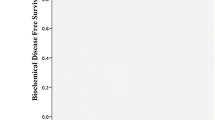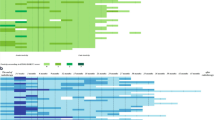Abstract
Purpose:
The aim was to evaluate treatment-related morbidity after intensity-modulated (IMRT) and image-guided (IGRT) radiotherapy with a total dose of 76 Gy in comparison to conventional conformal radiotherapy (3DCRT) up to 70.2–72 Gy for patients with prostate cancer.
Patients and Methods:
All patients were prospectively surveyed prior to, on the last day, as well as after a median time of 2 and 16 months after RT using a validated questionnaire (Expanded Prostate Cancer Index Composite). Criteria for the 78 matched pairs after IMRT vs. 3DCRT were patient age, use of antiandrogens, treatment volume (± whole pelvis), prognostic risk group, and urinary/bowel/sexual quality of life (QoL) before treatment.
Results:
QoL changes after dose-escalated IMRT were found to be similar to QoL changes after 3DCRT in all domains. Only sexual function scores more than 1 year after RT decreased slightly more after 3DCRT in comparison to IMRT (mean 9 vs. 6 points; p = 0.04), with erections firm enough for intercourse in 14% vs. 30% (p = 0.03). Painful bowel movements were reported more frequently after 3DCRT vs. IMRT 2 months after treatment (≥ once a day in 10% vs. 1%; p = 0.03), but a tendency for higher rectal bleeding rates was found after IMRT vs. 3DCRT more than 1 year after RT (≥ rarely in 20% vs. 9%; p = 0.06).
Conclusion:
Combination of dose escalation with technological advances (IMRT and IGRT) is not associated with increased morbidity for patients with prostate cancer.
Zusammenfassung
Ziel:
Ziel war die Analyse therapiebedingter Morbidität nach intensitätsmodulierter (IMRT) und bildgeführter (IGRT) Radiotherapie mit einer Gesamtdosis von 76 Gy im Vergleich zur konventionellen konformalen Radiotherapie (3DCRT) bis 70,2–72 Gy bei Patienten mit einem Prostatakarzinom.
Patienten und Methoden:
Alle Patienten wurden prospektiv vor Beginn, am letzten Tag, median 2 Monate und 16 Monate nach RT mittels eines validierten Fragebogens befragt (Expanded Prostate Cancer Index Composite). Kriterien für 78 gematchte Paare nach IMRT vs. 3DCRT waren das Patientenalter, der Einsatz eines Antiandrogens, Zielvolumen (± Becken), prognostische Risikogruppe und Lebensqualität (LQ) beim Wasserlassen/Stuhlgang/Sexualität vor der Behandlung.
Ergebnisse:
LQ-Veränderungen nach dosiseskalierter IMRT waren den LQ-Veränderungen nach 3DCRT in allen Domänen sehr ähnlich. Nur der Punktwert für die sexuelle Funktion fiel über ein Jahr nach der Behandlung nach 3DCRT etwas mehr als nach IMRT (durchschnittlich 9 vs. 6 Punkte; p = 0,04), mit ausreichender Erektion für Geschlechtsverkehr in 14% vs. 30% (p = 0,03). Schmerzhafter Stuhlgang wurde zwei Monate nach Therapie häufiger nach 3DCRT als nach IMRT berichtet (≥ 1-mal täglich in 10% vs. 1%; p = 0,03); jedoch fand sich über ein Jahr nach RT die Tendenz zu einer häufigeren Rate rektaler Blutungen nach IMRT als nach 3DCRT (≥ selten in 20% vs. 9%; p = 0,06).
Schlussfolgerung:
Die Verknüpfung einer Dosiseskalation mit technologischen Fortschritten (IMRT und IGRT) ist bei Patienten mit einem Prostatakarzinom nicht mit erhöhter Morbidität assoziiert.
Similar content being viewed by others
References
Akimoto T, Muramatsu H, Takahashi M et al. Rectal bleeding after hypofractionated radiotherapy for prostate cancer: correlation between clinical and dosimetric parameters and the incidence of grade 2 or worse rectal bleeding. Int J Radiat Oncol Biol Phys 2004;60:1033–1039.
Al-Mamgani A, van Putten WL, Heemsbergen WD et al. Update of dutch multicenter dose-escalation trial of radiotherapy for localized prostate cancer. Int J Radiat Oncol Biol Phys 2008;72:980–988.
Bohrer M, Schröder P, Welzel G et al. Reduced rectal toxicity with ultrasound-based image guided radiotherapy using BATTM (b-mode acquisition and targeting) for prostate cancer. Strahlenther Onkol 2008;184:674–678.
Brenner DJ. Fractionation and late rectal toxicity. Int J Radiat Oncol Biol Phys 2004;60:1013–1015.
de Crevoisier R, Tucker SL, Dong L et al. Increased risk of biochemical and local failure in patients with distended rectum on the planning CT for prostate cancer radiotherapy. Int J Radiat Oncol Biol Phys 2005;62:965–973.
De Meerleer GO, Vakaet L, Gersem W et al. Radiotherapy of prostate cancer with or without intensity modulated beams: a planning comparison. Int J Radiat Oncol Biol Phys 2000;47:639–648.
Fiorino C, Sanguineti G, Cozzarini C et al. Rectal dose-volume constraints in high-dose radiotherapy of localized prostate cancer. Int J Radiat Oncol Biol Phys 2003;57:953–962.
Ghadjar P, Gwerder N, Manser P et al. High-dose (80 Gy) intensity-modulated radiation therapy with daily image guidance as primary treatment for localized prostate cancer. Strahlenther Onkol 2010;186:687–692.
Goldner G, Bombosch H, Geinitz H et al. Moderate risk-adapted dose escalation with three-dimensional conformal radiotherapy of localized prostate cancer from 70 to 74 Gy. First report on 5-year morbidity and biochemical control from a prospective austrian-german multicenter phase II trial. Strahlenther Onkol 2009;185:94–100.
Goldner G, Dimopoulos J, Kirisits C et al. Moderate dose escalation in three-dimensional conformal localized prostate cancer radiotherapy: single-institutional experience in 398 patients comparing 66 Gy versus 70 Gy versus 74 Gy. Strahlenther Onkol 2009;185:438–445.
Goldner G, Tomicek B, Becker G et al. Proctitis after external-beam radiotherapy for prostate cancer classified by Vienna Rectoscopy Score and correlated with EORTC/RTOG score for late rectal toxicity: results of a prospective multicenter study of 166 patients. Int J Radiat Oncol Biol Phys 2007;67:78–83.
Guckenberger M, Ok S, Polat B et al. Toxicity after intensity-modulated, image-guided radiotherapy for prostate cancer. Strahlenther Onkol 2010;186:535–543.
International Commission on Radiation Units and Measurements (ICRU). Prescribing, recording and reporting photon beam therapy. ICRU Report 50. Bethesda: 1993:1–8.
Lee CT, Dong L, Ahamad AW et al. Comparison of treatment volumes and techniques in prostate cancer radiation therapy. Am J Clin Oncol 2005;28:618–625.
Luxton G, Hancock SL, Boyer AL et al. Dosimetry and radiobiologic model comparison of IMRT and 3D conformal radiotherapy in treatment of carcinoma of the prostate. Int J Radiat Oncol Biol Phys 2004;59:267–284.
Michalski JM, Winter K, Purdy JA et al. Toxicity after three-dimensional radiotherapy for prostate cancer on RTOG 9406 dose Level V. Int J Radiat Oncol Biol Phys 2005;62:706–703.
Partin AW, Mangold LA, Lamm DM et al. Comtemporary update of prostate cancer staging nomograms (Partin tables) for the new millennium. Urology 2001;58:843–848.
Pinkawa M, Holy R, Piroth MD et al. Consequential late effects after radiotherapy for prostate cancer — a prospective longitudinal quality of life study. Radiat Oncol 2010;5:27.
Pinkawa M, Holy R, Piroth MD et al. Intensity-modulated radiotherapy for prostate cancer implementing molecular imaging with 18F-choline PET-CT to define a simultaneous integrated boost. Strahlenther Onkol 2010;186:600–606.
Pinkawa M, Piroth MD, Fischedick K et al. Impact of the target volume (prostate alone vs. prostate with seminal vesicles) and fraction dose (1.8 Gy vs. 2.0 Gy) on quality of life changes after external-beam radiotherapy for prostate cancer. Strahlenther Onkol 2009;185:724–370.
Pinkawa M, Piroth MD, Holy R et al. Quality of life after whole pelvic versus prostate-only external beam radiotherapy for prostate cancer: a matched-pair comparison. Int J Radiat Oncol Biol Phys 2010 (in press).
Pinkawa M, Pursch-Lee M, Asadpour B et al. Image-guided radiotherapy for prostate cancer. Implementation of ultrasound-based prostate localization for the analysis of inter- and intrafraction organ motion. Strahlenther Onkol 2008;184:679–685.
Pinkawa M, Siluschek J, Gagel B et al. Postoperative radiotherapy for prostate cancer: evaluation of target motion and treatment techniques (intensity-modulated versus conformal radiotherapy). Strahlenther Onkol 2007; 183:23–29.
van der Wielen GJ, van Putten WL, Incrocci L et al. Sexual function after three-dimensional conformal radiotherapy for prostate cancer: results from a dose-escalation trial. Int J Radiat Oncol Biol Phys 2007;68:479–484.
Viani GA, Stefano EJ, Alfonso SL. Higher-than-conventional radiation doses in localized prostate cancer treatment: a meta-analysis of randomized, controlled trials. Int J Radiat Oncol Biol Phys 2009;74:1405–1418.
Volz-Sidiropoulou E, Pinkawa M, Fischedick K et al. Factor analysis of the Expanded Prostate Cancer Index Composite (EPIC) in a patient group after primary (external beam radiotherapy and permanent iodine-125 brachytherapy) and postoperative radiotherapy for prostate cancer. Curr Urol 2008;2:122–129.
Vordermark D, Schwab M, Ness-Dourdoumas R et al. Association of anorectal dose-volume histograms and impaired fecal continence after 3D conformal radiotherapy for carcinoma of the prostate. Radiother Oncol 2003;69:209–214.
Wei JT, Dunn RL, Litwin MS et al. Development and validation of the expanded prostate cancer index composite (epic) for comprehensive assessment of health-related quality of life in men with prostate cancer. Urology 2000;56:899–905.
Yaparpalvi R, Hong L, Mah D et al. ICRU reference dose in an era of intensity-modulated radiation therapy clinical trials: correlation with planning target volume mean dose and suitability for intensity-modulated radiation therapy dose prescription. Radiother Oncol 2009;89:347–352.
Zelefsky MJ, Levin EJ, Hunt M et al. Incidence of late rectal and urinary toxicities after three-dimensional conformal radiotherapy and intensity-modulated radiotherapy for localized prostate cancer. Int J Radiat Oncol Biol Phys 2008;70:1124–1129.
Author information
Authors and Affiliations
Corresponding author
Rights and permissions
About this article
Cite this article
Pinkawa, M., Piroth, M.D., Holy, R. et al. Combination of Dose Escalation with Technological Advances (Intensity-Modulated and Image-Guided Radiotherapy) Is Not Associated with Increased Morbidity for Patients with Prostate Cancer. Strahlenther Onkol 187, 479–484 (2011). https://doi.org/10.1007/s00066-011-2249-z
Received:
Accepted:
Published:
Issue Date:
DOI: https://doi.org/10.1007/s00066-011-2249-z
Key Words
- Prostate neoplasm
- Intensity-modulated radiotherapy
- Image-guided radiotherapy
- Conformal radiotherapy
- Quality of life




